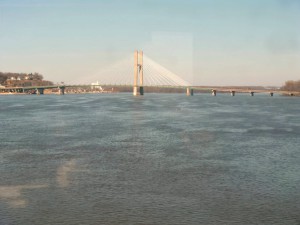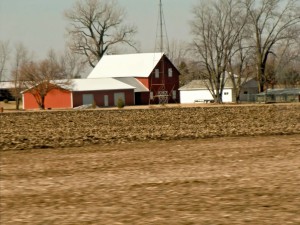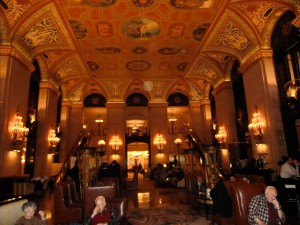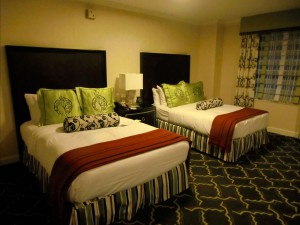IN SEARCH OF SNOW – THE HEART OF THE MIDWEST
IN SEARCH OF SNOW
This is the fourth in a series of articles about traveling by rail in search of snow
THE HEART OF THE MIDWEST
By Charles N. Stevens
Photos by Dolores Seidman
Our first view out of our train window at dawn is that of bare tree branches silhouetted against a steel-blue sky, patches of snow on the cold ground. As the sun rises it reveals rolling farmland, mostly bare, some of it white with a thin veneer of snow. Where the ground shows, the soil is gray or tan, the few trees leafless and stiff as iron. Many coal trains pass our Zephyr, the loaded ones moving east and the empties going west.
We pass a rural cemetery, its russet grass now winter-dead, as barren as death itself. Snow fills the furrows of plowed fields and lonely farmhouses and towering silos are scattered among them. We pause at the town of Creston, Iowa where a bank marquee tells us the temperature is 13 degrees. We are comfortable in the heated luxury of our train, but it chills us to peer out the window.
The Zephyr speeds eastward through endless farmland, puddles and ponds coated with ice, patches of black ice slick on the roads. What were once cornfields are now acres of stubble, the stalks all cut off evenly at eight inches, an amazing picture. More stubble and traces of snow race past our window, the land flat to gently rolling.
Our train zips through Osceola, Iowa, the sky clear and crisp without even a wisp of haze. Tall grain silos and elevators rise near the tracks. In another season they would be busy shipping grain all over the United States. We look down residential streets where the lawns are brown, the trees bare. As a Californian, I’m struck with the definiteness of the seasons in this part of the country.
We gaze out of the window, taking in the changing scenes that pass before us. Snow patches sparkle in the sun, the light reflecting off facets of frozen crystals. It reminds me of a line in one of Robert Louis Stevenson’s poems—“Frost makes the cart ruts beautiful.” Great rolls of hay scattered in the fields look like giant biscuits. The people are puffy, bundled in their jackets, but they appear to go about their work as though the chilly temperatures are nothing. However, there are few people about, the rest, I imagine, preferring to stay in the warmth of their homes.
Roaring through the small towns of Lucas and Charlton, our train flickers by more grain elevators and silos, a characteristic of the Iowa towns. A minute later we are looking at woods, the sun just reaching the earth between the lifeless trees. Cows and horses graze as though they are oblivious to the icy temperatures. As we speed eastward the land becomes hillier, some of the hills thick with forests, the snow on the ground more prevalent. Where the land is plowed, the upturned soil is as black as coal. Farther on, in a muddy field, hundreds of Canada geese feed on what’s left of grasses.
At Ottumwa, Iowa we get out of our coach for a face-freezing walk along side our train. The air seems to be pure Canadian, the breath off the flat, glacier-sheared fields of the north. We are glad to enter the warmth of the train again, our comfortable cocoon.
Soon after leaving the deteriorating train sheds of Burlington, Iowa, we cross the Mississippi River, wide and blue under the clear winter sky. Once across the river we are in Illinois, flat and rural farmland all around us. At close to 90 miles per hour the land from our train window is a level blur punctuated with silos and farm houses.
We pause again at Galesburg for another attempt to stretch our legs, to take a cheek-numbing walk along side the train. Dolores and I had visited Galesburg in 1975 so that we could visit the modest home of poet Carl Sandberg. It was a railroad town in Sandberg’s youth, his father an employee of the Chicago, Burlington and Quincy Railroad. We remembered too that Galesburg opened its first McDonald’s Restaurant when we were there. The crowds and traffic were so alarmingly large that the police had to be called to control it.
Continuing, we race over the rich black earth of Illinois farmland, a few traces of snow along ruts or by fences. There are many combination silos with a central tower and pipes leading to stainless steel storage tanks that gleam in the sun. Even rows of chopped-off cornstalks remind us of Iowa. From the train, the weather outside looks so benign, but once out in it, it cuts like knives.
We stop at Princeton with its brick station amid its cluster of “downtown” buildings. On our way again, the Zephyr breezes through small towns like, Mendota, Carleville, Yorkville, Aurora and Naperville, all very much the same with their water towers and grain elevators.
Once near Chicago our train slashes through industry, suburban towns and railroad yards, finally easing into the darkness of the cavernous Dearborn Street Station sheds. We detrain in the shadowed platforms, a cool wind chilling us to the bone. Once inside the station to pick up our bags, we’re warm again.
Taxies take us to the old but elegant Palmer House, a real treat. The lobby is spectacular with its high ceilings and decorated pillars, chandeliers casting soft light on each one. Each pillar ends in a curved arch that leads the eye to the ceiling with its medallions and scroll work. A bar is at one side, and throughout the lobby people sit in over-upholstered chairs and chat or drink beer out of tall glasses. We think about having dinner here, but it seems far over our budget.
Our room is quite spacious but over-decorated in the style of possibly the twenties, but good for one night. Cream-colored walls surround a dark green carpet latticed with a cream design. Upholstered lime-green chairs clash with a black dresser and desk, rounding out the unusual color scheme. The beds also carry out the theme, the comforter cream, the pillows lime-green, the headboard black.
It has been a long day, and we are ready for bed, despite the jarring colors that surround us.

After Burlington, Iowa we cross the Mississippi River, wide and blue under a clear winter sky.

The most common scenes in the Midwest are fields and farmhouses.

The lobby of the famous Palmer House Hotel in Chicago is breathtaking with its lights and columns.

The beds at the Palmer House have an unusual color scheme---cream, lime-green and black.



